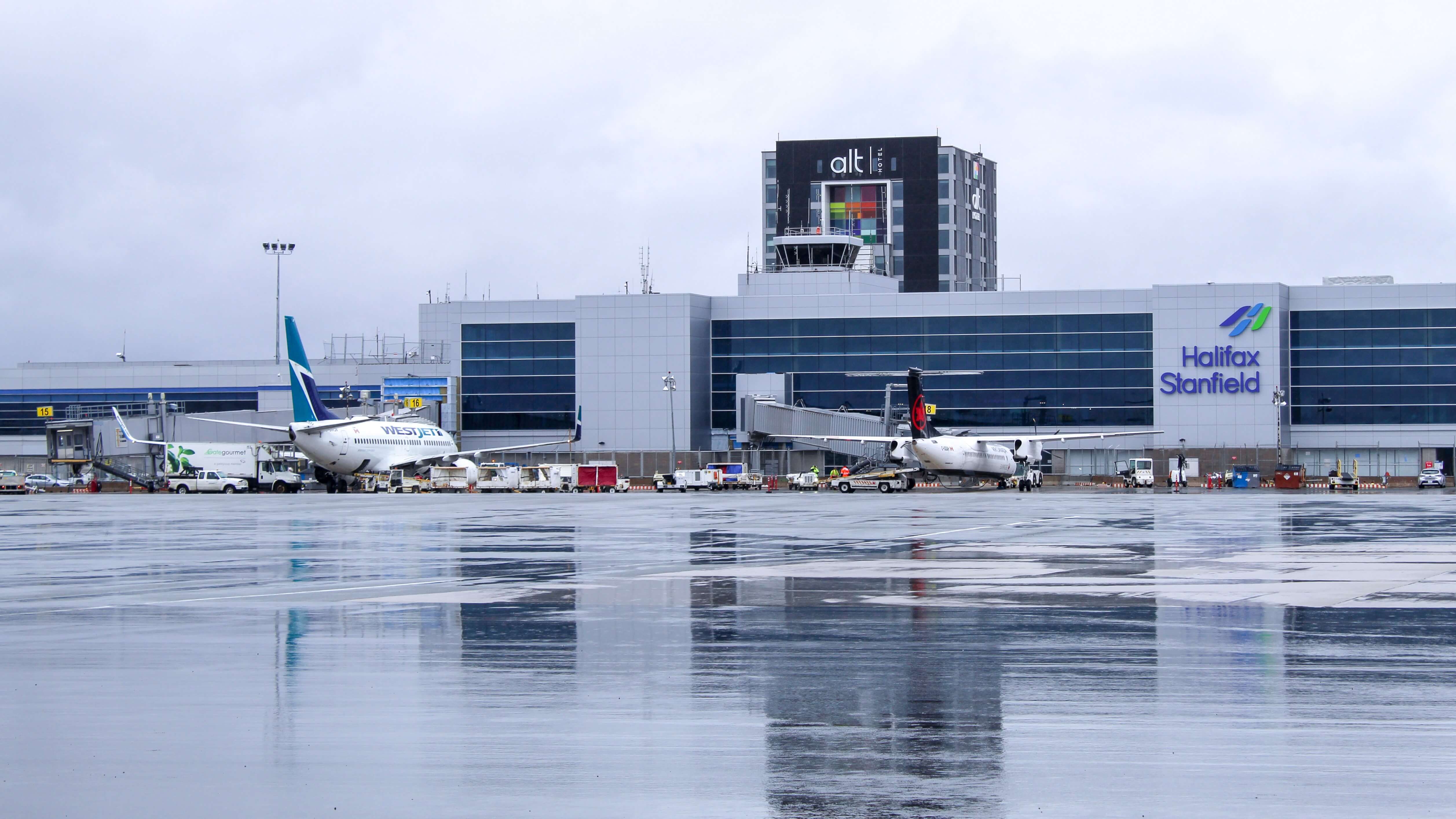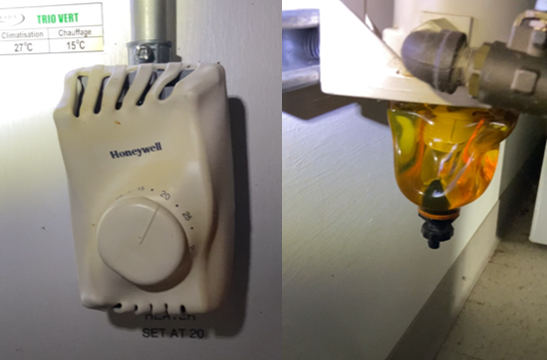







November 15, 2022
From the cab of the NAV CANADA Flight Service Station at Charlottetown International AirportOpen a new window, Tyson Morelli had a front row seat to Hurricane Fiona as it unleashed its powerful winds and torrential rain on Prince Edward Island.
“My colleagues and I have witnessed intense storms here before, but the damage caused by Fiona was worse than anything we’ve experienced in the past,” says Morelli, a NAV CANADA Site Manager. Morelli was one of many NAV CANADA employees who worked before, during, and after the post-tropical storm to protect, maintain, and restore critical air navigation technology and services across Atlantic Canada.
Before the storm made landfall on Saturday, September 24, Prince Edward Island’s Confederation BridgeOpen a new window closed to all traffic and ferries went out to seaOpen a new window to ride out the storm, virtually eliminating all ways for people to travel to or from the island. Charlottetown International Airport remained open to accommodate emergency services aircraft.
Shelley Christian, Vice President of Operations at the Charlottetown Airport Authority, says Charlottetown’s airport is a critical piece of infrastructure that needs to provide essential services at all times. “Whenever an aircraft needs to takeoff or land, we’re responsible for ensuring our airport is open and ready. Aviation professionals at our airport also provide pilots with fuel, supplies, and important weather and aeronautical information to help them make informed decisions about their flights,” says Christian. “Given that our province is located on an island, the aviation industry plays an important role in connecting us with the rest of Canada and the world.”
While airport authorities oversee the management, operation, and development of airports, NAV CANADA is responsible for the safe coordination and efficient movement of aircraft, and for planning and managing Canada’s airspace, including flight paths and airways used by airlines.
Here are two firsthand accounts from NAV CANADA employees about how they weathered Hurricane Fiona in Atlantic Canada.
.jpg)
NAV CANADA flight service station at Charlottetown International Airport. This photo was taken a few hours before Hurricane Fiona arrived in Charlottetown, Prince Edward Island.
Fiona's impact on Charlottetown International Airport, as experienced by Tyson Morelli, Air Traffic Operations Site Manager, NAV CANADA
In the days leading up to the storm, weather reports warned that Hurricane Fiona was going to be a powerful storm when it reached Atlantic Canada. I manage teams in both New Brunswick and Prince Edward Island, so when news broke that PEI would likely be hit the hardest I made the decision to drive to Charlottetown International Airport to support my colleagues working there at the NAV CANADA flight service station.
I picked up some food, water, and other basic supplies, thinking I might be away from home for a day or two, and joined my colleague Allan Drake, a Flight Service Specialist, at the tower. Allan was on duty that night and arrived early to relieve one of his colleagues so they could rush home and prepare for the storm. Together, we hunkered down at the tower to keep our operations running and wait out the storm.
Hurricane Fiona passes over Charlottetown International Airport.
At about 1 a.m., we lost power at the airport. Fortunately, we have many redundancies built into our operations, so our generator turned on power to our operational equipment. At about 3 a.m. the wind picked up to about 65 knots (120 km/hr) and we could feel the tower starting to sway in the wind. It felt like we were on a ship out at sea.
The cab is built to be soundproof, but we could hear the rain pounding against the windows and loud bangs on the roof. The noise was just incredible – it was like a freight train was racing by our window. We saw dumpsters tumbling across the parking lot and tree branches flying across the airfield. Around that same time, we lost our phone lines, so we had to rely on our cell phones to communicate.
Fiona's impact on Halifax Stanfield International Airport, as experienced by Denis Doiron, Technical Services Team Supervisor, NAV CANADA
The morning after the storm, one of my colleagues informed me that the Airport Surface Detection Equipment (ASDE) was not functioning at Halifax Stanfield International Airport (YHZ). This system uses radar and other surveillance technologies to help air navigation service professionals track the movement of aircraft and vehicles at airports. This tool is especially important at YHZ because the airport is frequently surrounded by fog, making it difficult to see aircraft and vehicles from the air traffic control tower with the naked eye.

Photo contributed by the Halifax International Airport Authority.
One of my fellow technical services team members and I went to the airport to check out the ASDE and we were immediately surprised to find the door handle to the room that houses the ASDE’s backup generator was hot. We surveyed the area for safety risks and carefully opened the door and felt a wave of hot air rush out. From there we could see some plastic items in the room, such as the thermostat, had melted due to the extreme heat. It was easily over 70 degrees celsius in there, so we let the room air out and cool down before going in to assess the damage.

Following Hurricane Fiona this thermostat and light, along with several other plastic items, melted in NAV CANADA’s backup generator room at Halifax Stanfield International Airport.
We believe that when the power got knocked out in Halifax, the backup generator turned on to power the ASDE. Then, the HVAC system malfunctioned, preventing the generator from cooling properly, resulting in the extreme heat. While the ASDE itself was not damaged in the storm, the backup generator, HVAC system and commercial power have undergone extensive maintenance and repair. It has been a true team effort.
.jpg)
NAV CANADA's Airport Surface Detection Equipment at Halifax Stanfield International Airport.
I’d like to thank my colleague Justin Steeves, Technical Services Technologist, for his dedication to keeping the ASDE spinning. Commercial power was locked out for safety reasons and a temporary portable generator was installed to power the ASDE until we could have the building’s generator fully repaired. Justin filled the temporary generator with fuel every two days, including weekends, for nearly four weeks, on top of his regular duties maintaining the Company’s air navigation service equipment. Thank you to Justin and everyone involved with the recovery efforts.
Across Canada, NAV CANADA operates roughly one hundred staffed sites and maintains technology at hundreds of locations. The Company’s dedicated employees deliver air traffic services, provide critical information, design and build technology, and maintain essential systems that help ensure the safe movement of aircraft. Want to join our team? Learn about careers at NAV CANADAOpen a new window.